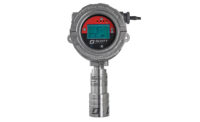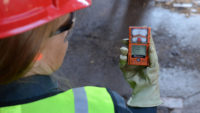Digital transformation meets the latest in combustible gas detection
Keeping everyone safe while ensuring efficient operations






The risk of gas leaks has been a common concern for decades in many industries, including oil and gas, petrochemical, utilities, mining, public safety and beyond. Combustible gases are commonly used throughout processes that produce raw materials needed to support our economy and result from biological breakdown of waste. Employees face the risk of gas-fueled explosions that can result in severe injuries, loss of life and destruction of property. These risks are amplified when several gases are present on a worksite, which can further complicate how to reliably monitor, identify and react to a potential leak.
To help ensure worker safety in hazardous environments, organizations continually review their strategies for how they address and prevent the threat of gas leaks, from real-time detection to proactive measures that mitigate future incidents.
Many personal gas monitors feature specialized combustible or flammable gas sensors. However, innovation in combustible gas detection has been stagnant for the last few decades, producing sensor technologies that must be calibrated to accurately measure the presence of just a single gas, resulting in higher or lower sensitivity to other flammable gases.
With many businesses conducting their digital transformation, connected safety innovations are keeping people safer and more efficient than ever before. An excellent example of this is a new sensor technology that just emerged and is set to disrupt flammable gas detection — and when connected — expands the overall situational view from digital transformation programs.
Accurately detecting multiple gases at once
While traditional flammable gas sensors, such as catalytic bead and non-dispersive infrared (NDIR) sensors, have been the primary conventional solutions to detect the Lower Explosive Limit (LEL) of flammable gas, they are calibrated to accurately detect one gas at a time. But what happens if an employee encounters another type of combustible gas on-site? This presents the potential for false alarms if the detected gas reads high and a lower reading than actual will present a higher level of risk to the worker.
For the first time in flammable gas detection, a new technology is available that equips users with a sensor that responds accurately to the 12 most common combustible gases. Blackline Safety has partnered with NevadaNano to bring their revolutionary micro-electro-mechanical systems (MEMS) flammable gas sensor to market as part of a cloud-connected gas detection ecosystem. The NevadaNano Molecular Property Spectrometer (MPSTM) Flammable Gas Sensor simultaneously detects multiple gasses as precisely as it does a single gas.
The best of both worlds
The two work-horse sensors of explosive gas detection, the pellistor and NDIR sensor, each have advantages and disadvantages to support their use. For example, pellistor sensors can detect hydrogen and acetylene detection well but are easily poisoned by silicones. NDIR sensors cannot be poisoned, but they don’t detect hydrogen or acetylene so are unacceptable for use in many petrochemical facilities. While NDIR sensors are susceptible to false alarms with high-rate environmental changes, pellistor sensors remain unaffected.
With the ability to detect hydrocarbons, hydrogen and acetylene, its intrinsic silicone resistance, as well as built-in environmental compensation, MPS technology has combined the best of the NDIR and pellistor capabilities to set the new standard for explosive gas detection in portable instruments. The MPS sensor has the ability to accurately identify and quantify the true lower explosive limit of single gas and mixtures at one time, called TrueLELTM — increasing gas detection performance, employee confidence and visibility into business operations. Additionally, this technology is immune to poisoning, meaning your sensors will last longer, read more accurately and most importantly, protect your people and assets to a greater extent than traditional pellistors. It also features a higher immunity to temperature and humidity shifts than an NDIR sensor, reducing the number of false alarms that can erode employee confidence in their personal gas monitors.
Combustible gas classification
Going a step further, the MPS sensor delivers the industry’s first classification system that places detected gases or mixtures into one of six categories:
Class 1: Hydrogen
Class 2: Hydrogen mixture with other flammable gases
Class 3: Methane or natural gas
Class 4: Light gas or a light-gas mixture
Class 5: Medium gas or medium gas mixture
Class 6: Heavy gas or heavy gas mixture
Whether it's a single gas or a mixture of gases, MPS delivers an accurate measurement of the actual LEL, factoring into the reading the current temperature, pressure and humidity.
Data science in the cloud
In conjunction with the latest combustible gas sensor technology, data science is a key component in attaining full worksite visibility, contributing to digital transformation goals. By combining the MPS sensor with wireless connectivity, gas readings and corresponding gas classifications can be streamed to cloud-hosted software. There, health and safety professionals can easily view interactive data analytics that present the classification, level, and location of each flammable gas reading workers encountered. This allows them to identify abnormalities, such as the new presence of hydrogen in one area of the facility, and proactively address the leak before personnel or the facility is placed at risk.
|
How do you monitor for combustible environments? When gas leaks happen on a worksite, there is a range of gas and air concentrations in which explosions are possible. This range varies for each flammable gas. The lowest point in that range is called the Lower Explosive Limit (LEL). Detecting an accurate percent LEL reading is critical as reaching 20% of this limit is cause for alarm and triggers an evacuation of personnel from the area to ensure the safety of workers. Combustible gas detectors, also known as LEL gas detectors, specialize in detecting these levels of flammable gases and preventing safety incidents. Twelve common combustible gases present on worksites include:

|
Looking for a reprint of this article?
From high-res PDFs to custom plaques, order your copy today!








